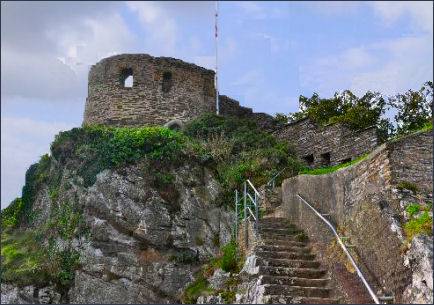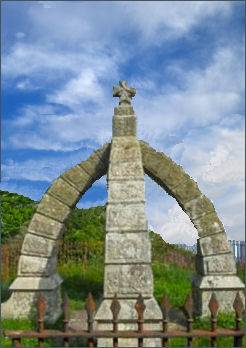St. Catherine's Castle
OS Grid ref:- SX 118 509
 St. Catherine's Castle at Fowey is one of a pair of small artillery forts which were constructed in 1536 by 'England's Bluebeard', King Henry VIII to defend the harbour at Fowey as part of a response to increased military threat from Spain and France in the aftermath of the Reformation.
St. Catherine's Castle at Fowey is one of a pair of small artillery forts which were constructed in 1536 by 'England's Bluebeard', King Henry VIII to defend the harbour at Fowey as part of a response to increased military threat from Spain and France in the aftermath of the Reformation.
Its name derives from the rocky headland at the entrance to the River Fowey estuary on which it stands, which is known as St Catherine's Point.
The castle was built by Thomas Treffry of Place (who was also responsible for the construction of St Mawes Castle. It has two storeys with gun ports at ground level. Steep slopes fall away from the blockhouse walls to a curtain wall and bastion which meets the cliffs either side. The remains of the castle overlook the estuary and can be accessed via a short path from the beach.
St. Catherine's Castle was manned by the Royalists during the first part of the Civil War (1642-6), but by 1684 it was described as in a "ruinous" condition.
In the mid nineteenth century the spectre of invasion raised its head again, during the Crimean War, which led to a general refortification of the south coast. A battery to house two guns was built at St. Catherine's Castle on the levelled platform on the tip of the headland below the fort, this was protected behind a parapet wall. A magazine was built into the rock beside the curtain wall entrance.
A twin battery of 64-pounder rifled muzzle-loading guns was added on a lower terrace in the nineteenth century. One emplacement was modified during the Second World War to mount a 4.7" naval gun inside a concrete shelter, but this was later removed to restore the Victorian gun races.
The castle is now owned by English Heritage, entrance is free. Parking is at Ready Money Cove Car Park, Fowey, which is around a three quarters of a mile walk.
Rashleigh Mausoleum
 High on wooded cliffs at St. Catherine's Point, standing just inland from the castle, the imposing Rashleigh mausoleum arches from the surrounding landscape and overlooks the spectacular view of the Fowey estuary. The eccentric mausoleum was built for William Rashleigh (1817 - 31 October 1871) in 1867, four years prior to his death.
High on wooded cliffs at St. Catherine's Point, standing just inland from the castle, the imposing Rashleigh mausoleum arches from the surrounding landscape and overlooks the spectacular view of the Fowey estuary. The eccentric mausoleum was built for William Rashleigh (1817 - 31 October 1871) in 1867, four years prior to his death.
Rashleigh was a Conservative Party politician, an MP for East Cornwall and the owner of Menabilly, which has been the seat of the Rashleigh family from the sixteenth century to the present day. The Rashleigh family originated as influential merchants in the sixteenth century.
The great bell-shaped structure of the mausoleum is formed by two interlocking granite arches surmounted by a cross. The floor beneath this crown contains two grave slabsWilliam Rashleigh is buried here at St Catherine's Point along with his wife Catherine Stuart and their daughter Edith Stopford Sackville. The Rashleigh Musoleum overlooks the superb Italian style house constructed by William at Point Neptune where he lived in preference to the family seat at Menabilly.
The mausoleum is built on the approximate site of St Catherine's Chapel, which dated from 1390. Coastal chapels such as St Catherine's and St Saviour's above Polruan, were used as landmarks and lighthouses as well as places of worship. In storms, fogs and bad weather the monks of the chapels would light beacons in the windows and toll bells to lead vessels away from the rocks and safely into harbour.
Historic Buildings in Cornwall